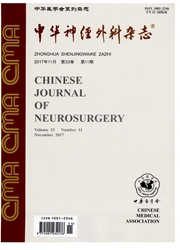

 中文摘要:
中文摘要:
目的 探讨抑制miR-106b过表达对人脑胶质瘤细胞株增殖和侵袭的影响.方法 培养人脑U251、LN229及TJ905胶质瘤细胞,并将其分为细胞对照组,转染阴性对照组(简称阴性对照组),转染miR-106b inhibitors组(简称106b inh组).将反义miR-106b用脂质体转染于人脑胶质瘤细胞中,抑制miR-106b的表达.采用实时定量PCR法检测转染后胶质瘤细胞miR-106b的表达,流式细胞术检测细胞周期的变化、噻唑兰比色分析法检测细胞增殖能力、软琼脂克隆形成实验评价细胞非锚定依赖性生长能力及Transwell实验检测细胞侵袭能力的变化.结果 与细胞对照组,阴性对照组比较,(1) 106b inh组3种胶质瘤细胞中miR-106b的表达均被明显抑制;细胞周期进展被抑制,S期细胞比例减少,G0/G1期细胞比例增加,其中U251、TJ905细胞的周期时相分布差异有统计学意义(P值均<0.05),LN229细胞的周期时相分布差异无统计学意义;(2) 106b inh组转染抑制后48 h,3种胶质瘤细胞的增殖能力均明显减弱,P< 0.05;(3)细胞的克隆形成能力也被明显抑制[克隆形成率分别为,U251:(10.6±0.9)%、(10.5±1.2)%对比(3.3±0.4)%;LN229:(12.5±1.7)%、(11.0±2.4)%对比(4.1±0.3)%;TJ905:(9.9±1.2)%、(10.2±0.6)%对比(3.5±0.4)%.P值均<0.01];(4)穿过Transwell小室的细胞数明显降低[U251:(90.6±5.7)、(85.2±6.1)个对比(27.6±4.0)个;LN229:(22.6±3.7)、(21.2±3.7)个对比(2.4±1.5)个;TJ905:(79.4±4.4)、(76.8±5.9)个对比(11.8±3.2)个.P值均<0.0l].结论 下调miR-106b的表达可抑制胶质瘤细胞的增殖、生长和侵袭能力.
 英文摘要:
英文摘要:
Objective To study the effect of miR-106b inhibitor on glioma cell line growth and invasive ability in vitro.Methods The miR-106b inhibitor was transfected by liposome to repress the expression of miR-106b,qRT-PCR was taken to measure miR-106b expression after tansfection.The cell cycle kinetics and cell proliferation rate were detected by floweytometry and MTT assay,the cell malignant proliferative ability was evaluated by soft agar assay,and the invasive ability was detected by transwell assay.Results The antisense oligonucleotide of miR-106b effectively down-regulated miR-106b expression in glioma cells.The progression of cell cycle was blocked.The rate of S phase decreased,and the rate of G0/G1 phase increased.The distribution of cell cycle was significantly different in U251 and TJ905 (P 〈 0.05),but not in LN229.After transfection for 48h,the proliferation activity of three cell lines was obviously inhibited.Also,the cell clone formation was repressed [The rate of clone efficiency:U251:(10.6 ± 0.9)%、(10.5 ± 1.2)% vs.(3.3 ± 0.4)%;LN229:(12.5 ± 1.7)%、(11.0 ± 2.4)% vs.(4.1 ± 0.3)%;TJ905:(9.9 ± 1.2)%、(10.2 ± 0.6)% vs.(3.5 ± 0.4)%.P 〈 0.01].The invasive ability was also significantly repressed in cells transfected with miR-106b inhibitor as compared to those of the cells transfected with negative control oligonucleotide and control cells [The cell number per view was U251:(90.6±5.7),(85.2±6.1) vs.(27.6±4.0);LN229:(22.6 ±3.7),(21.2±3.7) vs.(2.4 ± 1.5); T J905:(79.4 ± 4.4),(76.8 ± 5.9) vs.(11.8 ± 3.2).P 〈 0.01].Conclusions Suppression of miR-106b expression could inhibit the proliferative and invasive ability of glioma cells.
 同期刊论文项目
同期刊论文项目
 同项目期刊论文
同项目期刊论文
 期刊信息
期刊信息
